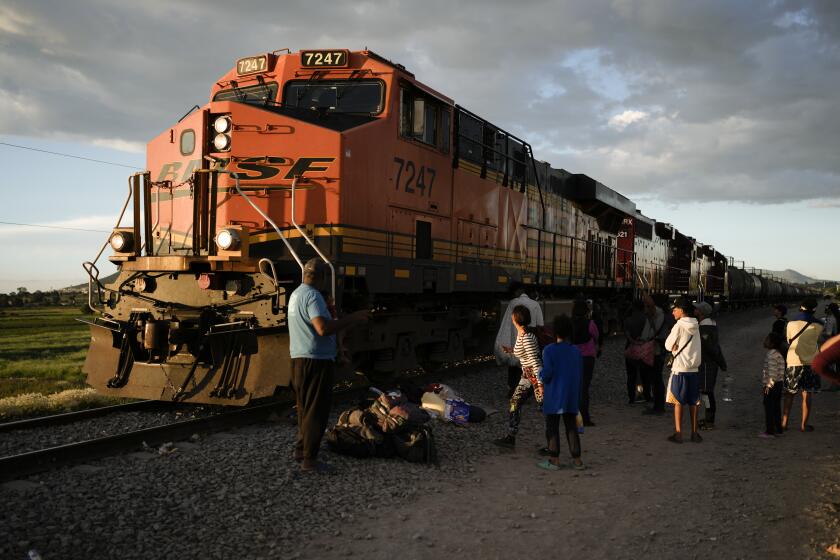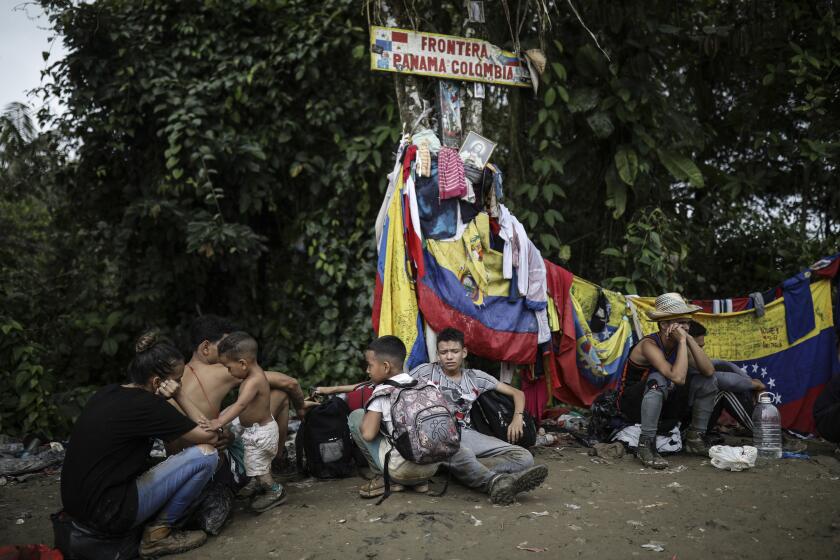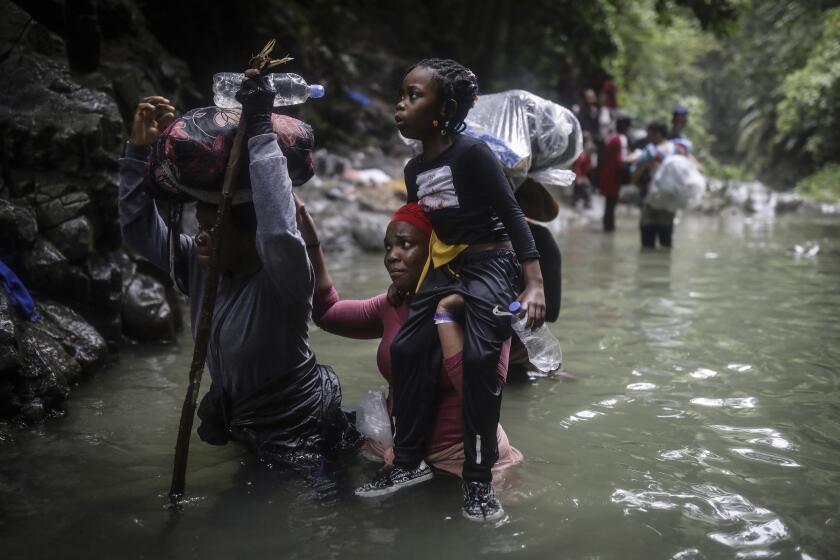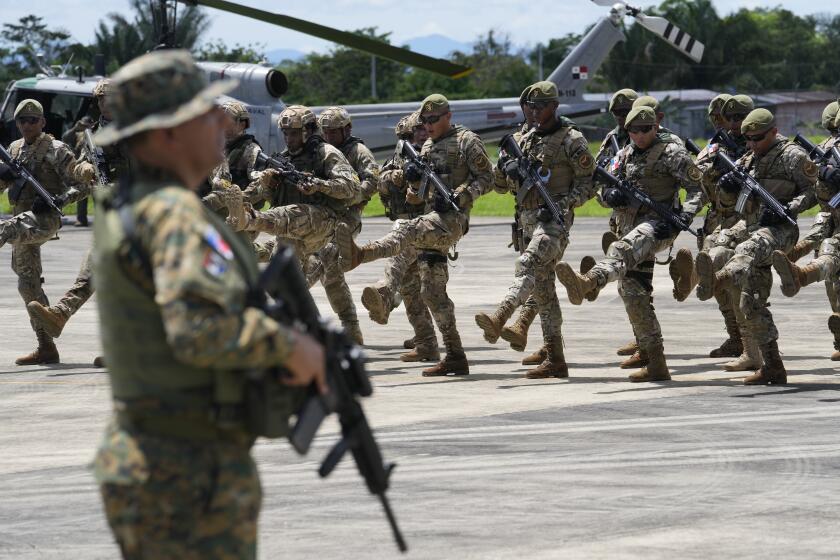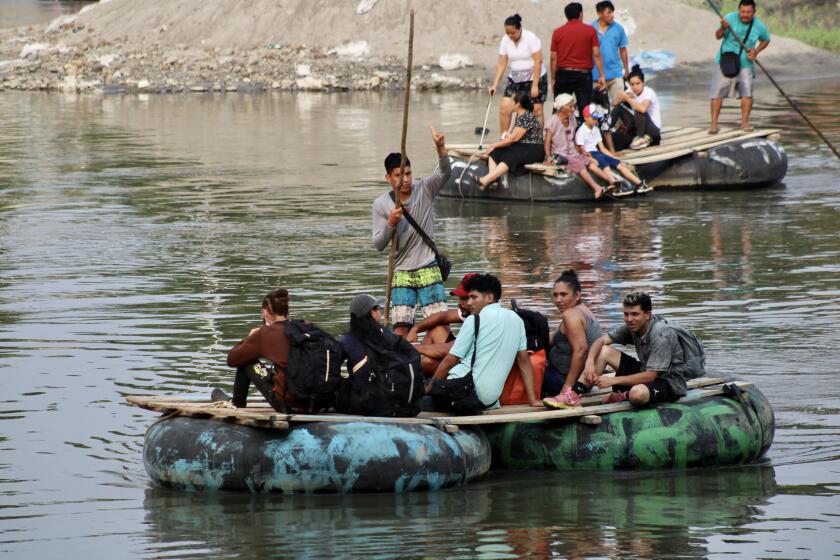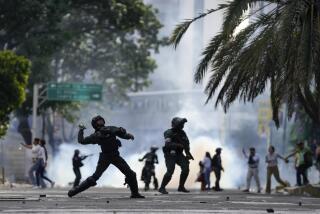Wave of migrants that halted trains in Mexico started with migrant smuggling industry in Darien Gap
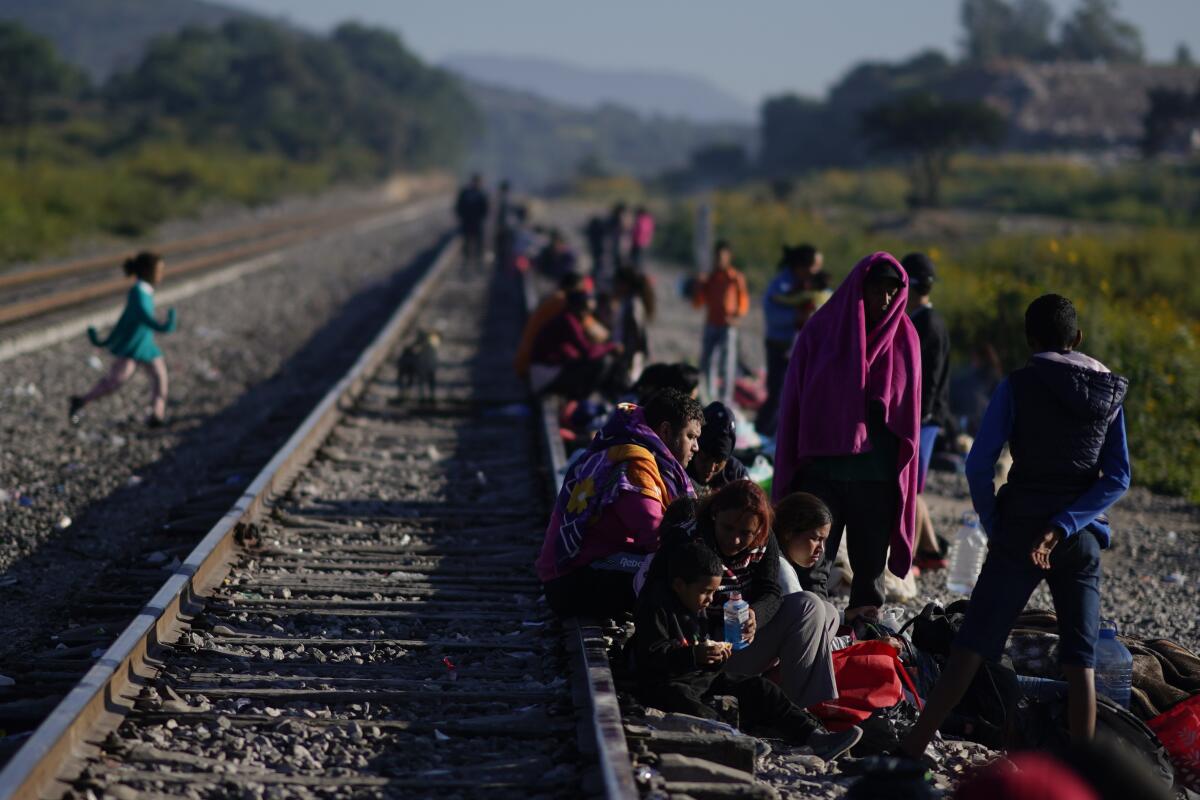
- Share via
HUEHUETOCA, Mexico — Thousands of migrants riding atop railway cars in Mexico this week or waiting in mile-long lines by the tracks to hitch a ride to the U.S. have triggered the closure of one U.S. border crossing and forced Mexico’s largest railroad to suspend dozens of freight trains.
But the surge has also revealed a much larger phenomenon — an almost unbroken chain of migrants being shuffled from Colombia through the Darien Gap jungle through Panama on an industrial scale that could approach 500,000 this year.
Those migrants are then moving steadily without interruption up through Central America into Mexico and on to the U.S. border.
“Behind us, there are thousands more. It’s continuous,” Juan Carlos Leal, a Venezuelan migrant who was waiting Wednesday with his 5-year-old son beside railroad tracks about 35 miles north of Mexico City.
A Mexican railway operator says it is suspending trains in the northern part of the country because so many migrants are climbing aboard freight cars.
He and other migrants waiting to hop passing trains — some while still running — in the Mexican town of Huehuetoca said 3,500 migrants are being moved every day through jungle camps organized by smugglers in Colombia, south of Panama’s Darien Gap, because that is the number of people that can fit in each camp.
The dangerous jungle crossing has been reduced from over a week to as little as two days for the strongest walkers, by a network of guides, established camps and rudimentary trail markers that start in the Necocli, on Colombia’s side of the gap.
Venezuelan migrants in Huehuetoca said the Darien operation appears to be dominated by Colombian paramilitary groups, which funnel part of their proceeds to Panama’s autonomous Indigenous groups.
Panama’s government said last week that it would increase deportations to confront the record-breaking flow of migrants through Darien.
The smuggling network can now get migrants from Venezuela to central Mexico in as little as just over two weeks, an odyssey that once could take months. Detentions along the U.S.-Mexico border soared 33% from June to July, according to U.S. government figures, reversing a plunge after new asylum restrictions were introduced in May.
The government of Panama says it will launch a new campaign to stem the flow of migrants through the dangerous, jungle-clad Darien Gap.
“It’s in their interest to move people through as quickly as possible,” Venezuelan migrant Jose Javier Fereira said of the gangs running the smuggling. “This is not going to stop until they put a stop to the mafia in Necocli.”
A former taxi driver, Fereira said he simply could not earn a living in Venezuela because gasoline is too expensive for those who are not politically connected. At the same time, he decided to leave his family at home because the journey was just too dangerous.
That was not the case for everyone. Entire families waited to hop freight cars in Huehuetoca.
Mayerlin Bracamontes cuddled and played with her 5-month-old daughter as she waited for a train. “It is dangerous,” she acknowledged, but said she was accompanied by fellow Venezuelans who would help her pass the baby to waiting hands of those already aboard a train.
The migrants are still preyed upon by corrupt officials, gangs, thieves and sexual abusers almost every step of the way. At least a half dozen of the migrants in Huehuetoca described seeing the same bodies — those of a woman and her newborn baby, a young couple, an older, heavy-set man — decomposing along the jungle trail in Darien.
Panama has unveiled a new effort to control illegal migration through the treacherous Darien Gap that spans its eastern border with Colombia.
Migrants also agreed in describing details of the smuggling industry in Colombia: Smugglers attach two concert-style bracelets to the wrists of migrants who have paid the minimum $350 smuggling fee. One bracelet signifies the migrant has paid the gang tax, the other signifies a cut has been given to Panamanian Indigenous groups through whose territory the migrants pass.
Beyond the jungle, migrants have fewer complaints about Panama, Costa Rica and Nicaragua, saying officials there mostly seemed to want to move the migrants quickly along to get them out of their countries fast.
For Guatemala, however, almost all the migrants reported repeated sexual abuse and extortion by Guatemalan police.
But it is in Mexico where they face perhaps the deadliest part of their journey, apart from the jungle: hopping aboard freight trains. Migrants have long crossed Mexico aboard the trains, collectively known as “The Beast,” at levels that fluctuated with efforts to keep them off.
Usually they board when a train stops to switch tracks. They prefer climbing onto freight cars, which have flat tops with ladders and railings that offer handholds. But in their desperation, some migrants also crowd onto the narrow, un-railed tops of tank cars, where falling asleep or being jostled can lead to a fatal fall.
Operation Shield is part of an agreement reached with the governments of Colombia and the United States in April to stop the flow of migrants.
Mexico’s largest railroad, Ferromex, said Tuesday it had temporarily halted 60 freight trains because so many migrants had climbed aboard that it was unsafe to move the cars. In recent days, there have been about a “half-dozen regrettable cases of injuries or deaths” among migrants, it said in a statement.
The company, owned by conglomerate Grupo Mexico, said some migrants even were jumping on moving freight cars “despite the grave danger that represents.”
The flood of migrants into Eagle Pass, Texas, led U.S. Customs and Border Protection to close one of two bridges leading into the city from the Mexican town of Piedras Negras. The agency said the bridge was temporarily closed “in order to redirect personnel to assist the U.S. Border Patrol with taking migrants into custody.”
For migrants who had already traveled thousands of miles, the idea of hitching a train ride was daunting.
“If I had known how dangerous it was going to be, I would have stayed to die in Venezuela with my family,” said Félix Rodríguez, a migrant from Barquisimeto, Venezuela, who was traveling with his wife and two sons, aged 13 and 14.
Rodríguez refused to take the risk of boarding a train that passed by Huehuetoca on Tuesday night, judging it too risky.
Following the expiration of Title 42, U.S.-bound migrants are still arriving at Mexico’s southern border to travel north, in a chaotic scene.
Instead, he walked away from the tracks, saying he and his family would sell snacks in the streets or wash car windows to raise enough money for bus tickets to the border.
“It’s dangerous to get on board with children, but a lot of people die to reach their dream,” Rodríguez said.
That approach carries its own risk. Migrants prefer the train not just because it costs nothing to ride, but because Mexican police and immigration agents frequently pull migrants off buses, saying the humanitarian visa or asylum application papers they carry don’t allow them to travel into Mexico’s north.
One thing the surge is not, is a caravan of the kind that saw 10,000 to 15,000 migrants — mainly from Central America — walk and hitchhike across Mexico in disciplined groups in 2018 and 2019.
The migrants crossing Mexico on trains this week often did not know which border town they would head to, and they traveled in the company only of relatives or a small group of friends.
“We Venezuelans take care of each other, that is something we have,” one migrant said as he offered to help boost Bracamontes’ 5-month-old baby aboard a train.
More to Read
Sign up for Essential California
The most important California stories and recommendations in your inbox every morning.
You may occasionally receive promotional content from the Los Angeles Times.
